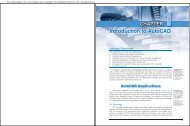Chapter 1 - Goodheart-Willcox
Chapter 1 - Goodheart-Willcox
Chapter 1 - Goodheart-Willcox
You also want an ePaper? Increase the reach of your titles
YUMPU automatically turns print PDFs into web optimized ePapers that Google loves.
28 <strong>Chapter</strong> 1 A Close-Up View of You<br />
section<br />
1:2<br />
Heredity<br />
Sharpen Your Reading<br />
Diagram the concepts of heredity using a graphic<br />
organizer. As you read, fill in key points along the<br />
branches. Use the following headings: Who<br />
Am I?—Your Identity and Hereditary Factors.<br />
Boost Your Vocabulary<br />
Draw a diagram that shows how information flows in<br />
the brain from one nerve cell to another.<br />
Know Key Terms<br />
heredity<br />
genetics<br />
chromosomes<br />
traits<br />
Punnett square<br />
intelligence<br />
neurons<br />
dendrites<br />
synapse<br />
neurotransmitters<br />
carrier<br />
family tree<br />
When planning for the future, it can help to<br />
look at the influences that shaped your life in the<br />
past. These factors often continue to influence<br />
you. One main factor that affects personal<br />
development is heredity. Your heredity is the<br />
sum of the qualities that were passed from your<br />
ancestors through your parents to you, 1-4. The<br />
1-4 These children have physical characteristics similar<br />
to their parents’ because of heredity.<br />
qualities you inherit make you a unique human<br />
being. Your hair color, facial features, and height<br />
are examples.<br />
Besides influencing all your physical qualities,<br />
heredity is a major factor in your personality<br />
development. Your heredity influences the way<br />
you look, feel, and behave. Knowing about the<br />
qualities you inherit will give you some insight<br />
to your own potential development. You will also<br />
pass on to your children part of what you inherit<br />
from your parents. The science that studies<br />
heredity is called genetics.<br />
Genes<br />
Each human being begins life with his<br />
or her own set of genetic material. A person<br />
normally inherits 23 rod-shaped particles called<br />
chromosomes from each biological parent.<br />
Chromosomes carry hereditary information<br />
from each parent. The father and mother each<br />
contribute 23 chromosomes. The child inherits a<br />
total of 46 chromosomes. This genetic “blueprint”<br />
exists in the nucleus of every cell in the body.<br />
Chromosomes contain long, ladder-type<br />
strands of DNA that carry genetic information.<br />
The parts of the ladder that carry information<br />
occur in pairs. These are the genes. There are<br />
about 30,000 genes. Genes determine all inherited<br />
characteristics, or traits.<br />
Physical Characteristics<br />
The genes you inherit affect your body. Your<br />
physical appearance may be similar to a brother,<br />
sister, or another family member because of<br />
inherited genes. However, the genes that come<br />
from both parents combine in different patterns<br />
in their children. As a result, brothers and sisters<br />
have different traits.<br />
Are you tall, short, or average height? Are<br />
you male or female? What color are your eyes,<br />
hair, and skin? These are some of your inherited<br />
traits.<br />
Dominant and Recessive<br />
Genes<br />
Some genes are dominant while others are<br />
recessive.<br />
When present, dominant genes determine<br />
the nature of a certain trait in a person. A<br />
dominant gene always overrules a recessive<br />
gene. Chart 1-5 lists some examples of<br />
physical traits that are dominant.<br />
Recessive genes determine the nature of the<br />
trait only when two of them are present. The<br />
child must receive one recessive gene from<br />
each parent.<br />
Black or brown hair<br />
Full lips<br />
Free earlobes<br />
Dimples in cheeks<br />
High and narrow<br />
nose<br />
Brown eyes<br />
Section 1:2 Heredity 29<br />
Scientists use letters such as DD and rr to<br />
identify a person’s genotype for various traits. A<br />
genotype is the genetic makeup of an individual<br />
or group. Capital D signifies a dominant trait<br />
such as brown hair. A lowercase r signifies a<br />
recessive trait such as blonde hair. A person<br />
with two dominant genes, genotype DD, will<br />
have brown hair. A person with one recessive<br />
and one dominant gene, genotype rD, will also<br />
have brown hair because the dominant D gene<br />
is present. A person with two recessive genes,<br />
genotype rr, will have blonde hair. In the case of<br />
eye color, a person with two recessive genes will<br />
have blue eyes.<br />
Scientists use a Punnett square, invented by<br />
R.C. Punnett, to determine what possible gene<br />
pairs may result from combining two genes, 1-6.<br />
The genes of the parents are identified along two<br />
adjacent sides of the square—one parent per<br />
side. Each possible combination is recorded in<br />
an inner box. A total of four combinations are<br />
possible. Consequently, each offspring will have a<br />
25 percent chance of inheriting the characteristic<br />
indicated in each box.<br />
Many traits are influenced by more than one<br />
pair of genes. For example, height seems to be<br />
determined by at least four pairs of genes. When<br />
several genes influence a trait, more variations<br />
may result in offspring.<br />
Inherited Traits<br />
Dominant Traits Recessive Traits<br />
Long full lashes<br />
Curly hair<br />
Freckles<br />
Feet with normal<br />
arches<br />
Farsightedness and<br />
astigmatism<br />
Blond hair<br />
Thin lips<br />
Attached earlobes<br />
No dimples in<br />
cheeks<br />
Broad nose<br />
Blue eyes<br />
1-5 This chart shows some of the inherited traits that dominate over recessive traits.<br />
Short thin lashes<br />
Straight hair<br />
Lack of freckles<br />
Flat feet<br />
Normal vision

















